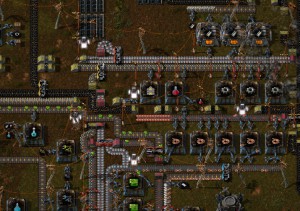Factorio
During my ongoing literature review I often discover interesting facts about things I’ve never thought about. Sometimes I can connect these facts with my own observations: The result is mostly a completely new idea why things are as they are. Maybe these ideas are new to you, too. Therefore I’ll share my new science based knowledge with you!
This week: This time, I think about the training effects of playing Factorio–a game in which the player is building huge factories.
Over the last one and a half months, I was occasionally playing Factorio[1]. The story of the game is quite simple: the player lands on the surface of an unknown planet and is in charge of preparing the arrival and the landing of other space ships by researching and building a „Rocket defense“.
The gameplay itself evolves around this research project. The player has to mine and process resources in order to research technologies or to build more advanced buildings. At first, the player can choose only between a few buildings in order to produce the materials needed for the first research project. Over time, he gets access to more advanced buildings which can assemble more complex items on a much faster rate. Moreover, the player is then able to automate the production by linking up production buildings with conveyor belts. In the end, the player is able to set up production cycles in order to automate the research process: the player is building a giant factory.
The most interesting thing about the game is the way of automating assembly processes. Each item in the game is assembled out of a certain amount of different materials. For example, assembling an „Electronic Circuit“ needs one „Iron Plate“ and three „Copper Cables“. An „Iron Plate“ is produced by smelting some „Iron Ore“ which is a mineable resource. Two „Copper Cables“ are produced by processing one „Copper Plate“. A „Copper Plate“ is produced by smelting some „Copper Ore“ which is a mineable resource.
In order to automate the production of „Electronic Circuits“, the player needs to begin the production cycle by setting up some mining drills. These buildings start to produce some ore which has to be transported to furnaces in order to transform it into iron or copper plates. The iron plate can be transported directly to the assembly machine for the electronic circuits. The copper plate however needs to be transported to another assembly machine which is producing the needed copper cables. Finally, all the needed materials are produced and the assembly machine can start producing „Electronic Circuits“.
The described production cycle is just one of many other complex production cycles in Factorio. The player is challenged to link up the different machines in the right order to finally produce all the items which are needed to advance a research project. Furthermore, the player needs to make sure that enough materials are mined in order to keep the production running. Moreover, it is also important to have a focus on the ratio of needed materials for each production process. The abovementioned production of electronic circuits needs more copper than iron. The player has to keep this in mind while he is setting up the production cycle.
The gameplay of Factorio is challenging the player to understand and analyze complex production cycles. On the one hand, the player needs to analyze the ratio of needed materials to prevent bottlenecks in the production. On the other hand, the player needs to be able to analyze the own infrastructure in order to improve less efficient parts of the giant factory.
In the end, my assumption is that Factorio is mostly challenging and training the problem solving ability of the users. Moreover, the game is training the cognitive ability to analyze complex processes and to realize these processes in form of a giant factory.
